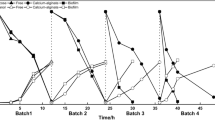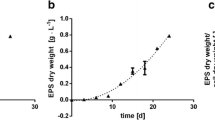Abstract
Fungal biofilm is known to promote the excretion of secondary metabolites in accordance with solid-state-related physiological mechanisms. This work is based on the comparative analysis of classical submerged fermentation with a fungal biofilm reactor for the production of a Gla::green fluorescent protein (GFP) fusion protein by Aspergillus oryzae. The biofilm reactor comprises a metal structured packing allowing the attachment of the fungal biomass. Since the production of the target protein is under the control of the promoter glaB, specifically induced in solid-state fermentation, the biofilm mode of culture is expected to enhance the global productivity. Although production of the target protein was enhanced by using the biofilm mode of culture, we also found that fusion protein production is also significant when the submerged mode of culture is used. This result is related to high shear stress leading to biomass autolysis and leakage of intracellular fusion protein into the extracellular medium. Moreover, 2-D gel electrophoresis highlights the preservation of fusion protein integrity produced in biofilm conditions. Two fungal biofilm reactor designs were then investigated further, i.e. with full immersion of the packing or with medium recirculation on the packing, and the scale-up potentialities were evaluated. In this context, it has been shown that full immersion of the metal packing in the liquid medium during cultivation allows for a uniform colonization of the packing by the fungal biomass and leads to a better quality of the fusion protein.








Similar content being viewed by others
References
Aferka S, Viva A, Brunazzi E, Marchot P, Crine M, Toye D (2011) Tomographic measurement of liquid hold up and effective interfacial area distributions in a column packed with high performance structured packings. Chem Eng Sci 66(14):3413–3422
Amadio J, Casey E, Murphy CD (2013) Filamentous fungal biofilm for production of human drug metabolites. Appl Microbiol Biotechnol 97(13):5955–5963
Barrios-González J (2012) Solid-state fermentation: physiology of solid medium, its molecular basis and applications. Process Biochem 47:175–185
Barrios-González J, Baños JG, Covarrubias AA, Garay-Arroyo A (2008) Lovastatin biosynthetic genes of Aspergillus terreus are expressed differentially in solid-state and in liquid submerged fermentation. Appl Microbiol Biotechnol 79(2):179–186
Bauwens J, Millet C, Tarayre C, Brasseur C, Destain J, Vandenbol M, Thonart P, Portetelle D, Pauw ED, Haubruge E, Francis F (2013) Symbiont diversity in Reticulitermes santonensis (Isoptera: Rhinotermitidae): investigation strategy through proteomics. Environ Entomol 42(5):882–887
Bhargav S, Panda BP, Ali M, Javed S (2008) Solid-state fermentation: an overview. Chem Biochem Eng Q 22(1):49–70
Cheng KC, Demirci A, Catchmark JM (2010) Advances in biofilm reactors for production of value-added products. Appl Microbiol Biotechnol 87(2):445–456
El-Enshasy HA (2007) Filamentous fungal cultures—process characteristics, products and applications. In: Yang S-T (ed) Bioprocessing for value-added products from renewable resources. Elsevier, Dayton, pp 225–261
Gamarra NN, Villena GK, Gutiérrez-Correa M (2010) Cellulase production by Aspergillus niger in biofilm, solid-state, and submerged fermentations. Appl Biochem Biotechnol 87:545–551
George N, Phillips J (1997) Structure and dynamics of green fluorescent protein. Curr Opin Struct Biol 7:821–827
Gordon CL, Archer DB, Jeenes DJ, Doonan JH, Wells B, Trinci APJ, Robson GD (2000) A glucoamylase::GFP gene fusion to study protein secretion by individual hyphae of Aspergillus niger. J Microbiol Method 42(1):39–48. doi:10.1016/S0167-7012(00)00170-6
Grimm LH, Kelly S, Krull R, Hempel DC (2005) Morphology and productivity of filamentous fungi. Appl Microbiol Biotechnol 69(4):375–384. doi:10.1007/s00253-005-0213-5
Gross R, Hauer B, Otto K, Schmid A (2007) Microbial biofilms: new catalysts for maximizing productivity of long-term biotransformations. Biotechnol Bioeng 98(6):1123–1134
Gutiérrez-Correa M, Ludena Y, Ramage G, Villena GK (2012) Recent advances on filamentous fungal biofilms for industrial uses. Appl Biochem Biotechnol 167(5):1235–1253
Harding MW, Marques LLR, Howard RJ, Olson ME (2009) Can filamentous fungi form biofilms? Trends Microbiol 17(11):475–480. doi:10.1016/j.tim.2009.08.007
Hartingsveldt W, Mattern I, Zeijl CJ, Pouwels P, Hondel CMJJ (1987) Development of a homologous transformation system for Aspergillus niger based on the pyrG gene. Mol Gen Genet 206(1):71–75. doi:10.1007/BF00326538
Hata Y (2002) Gene expression in solid-state culture of Aspergillus oryzae. Nippon Nog Kag Kaish 76(8):715–718
Hisada H, Sano M, Ishida H, Hata Y, Machida M (2013) Identification of regulatory elements in the glucoamylase-encoding gene (glaB) promoter from Aspergillus oryzae. Appl Microbiol Biotechnol 97(11):4951–4956
Ishida H, Hata Y, Ichikawa E, Kawato A, Suginami K, Imayasu S (1998) Regulation of the glucoamylase-encoding gene (glaB), expressed in solid- state culture (koji) of Aspergillus oryzae. J Ferment Bioeng 86(3):301–307
Ishida H, Hata Y, Kawato A, Abe Y, Suginami K, Imayasu S (2000) Identification of functional elements that regulate the glucoamylase-encoding gene (glaB) expressed in solid-state culture of Aspergillus oryzae. Curr Genet 37(6):373–379
Ishida H, Hata Y, Kawato A, Abe Y (2006) Improvement of the glaB promoter expressed in solid-state fermentation (SSF) of Aspergillus oryzae. Biosci Biotechnol Biochem 70(5):1181–1187
Khalesi M, Zune Q, Telek S, Riveros-Galan D, Verachtert H, Toye D, Gebruers K, Derdelinckx G, Delvigne F (2014) Fungal biofilm reactor improves the productivity of hydrophobin HFBII. Biochem Eng J 88:171–178
Lan TQ, Wei D, Yang ST, Liu X (2013) Enhanced cellulase production by Trichoderma viride in a rotating fibrous bed bioreactor. Bioresour Technol 133:175–182
Lee J, Paetzel M (2011) Structure of the catalytic domain of glucoamylase from Aspergillus niger. Acta Crystallogr Sect A: Found Crystallogr F67:188–192
Li XZ, Hauer B, Rosche B (2013) Catalytic biofilms on structured packing for the production of glycolic acid. J Microbiol Biotechnol 23(2):195–204
Papagianni M (2004) Fungal morphology and metabolites production in submerged mycelial process. Biotechnol Adv 22:189–259
Papagianni M, Moo-Young M (2002) Protease secretion in glucoamylase producer Aspergillus niger cultures: fungal morphology and inoculum effects. Process Biochem 37(11):1271–1278. doi:10.1016/S0032-9592(02)00002-X
Qureshi N, Annous BA, Ezeji TC, Karcher P, Maddox IS (2005) Biofilm reactors for industrial bioconversion process: employing potential of enhanced reaction rates. Microb Cell Fact 4(24):1–21
Rosche B, Li XZ, Hauer B, Schmid A, Buehler K (2009) Microbial biofilms: a concept for industrial catalysis? Trends Biotechnol 27(11):636–643. doi:10.1016/j.tibtech.2009.08.001
Russel D, Oldham N, Davis B (2009) Site-selective chemical protein glycosylation protects from autolysis and proteolytic degradation. Carbohydr Res 344(12):1508–1514
Seferian KR, Tamm NN, Semenov AG, Tolstaya AA, Koshkina EV, Krasnoselsky MI, Postnikov AB, Serebryanaya DV, Apple FS, Murakami MM, Katrukha AG (2008) Immunodetection of glycosylated NT-proBNP circulating in human blood. Clin Chem 54(5):866–873. doi:10.1373/clinchem.2007.100040
Stewart PS, Franklin MJ (2008) Physiological heterogeneity in biofilms. Nat Rev Microbiol 6(3):199–210. doi:10.1038/nrmicro1838
Sugita A, Sugii A, Sato K, Zhang X-Y, Dai A-L, Taguchi G, Makoto S (2012) Cloning and characterization of gene coding for a major extracellular chitosanase from the koji mold Aspergillus oryzae. Biosci Biotechnol Biochem 76:193–195
Talabardon M, Yang ST (2005) Production of GFP and glucoamylase by recombinant Aspergillus niger: effects of fermentation conditions on fungal morphology and protein secretion. Biotechnol Prog 21(5):1389–1400
Tamano K, Satoh Y, Ishii T, Terabayashi Y, Ohtaki S, Sano M, Takahashi T, Koyama Y, Mizutani O, Abe K, Machida M (2007) The β-1-3-exoglucanase gene (exgA) of Aspergillus oryzae is required to catabolize extracellular glucan, and is induced in growth on a solid surface. Biosci Biotechnol Biochem 71(4):926–934
Te Biesebeke R, Ruijter G, Rahardjo YSP, Hoogschagen MJ, Heerikhuisen M, Levin A, van Driel KGA, Schutyser MAI, Dijksterhuis J, Zhu Y, Weber FJ, de Vos WM, van den Hondel KAMJJ, Rinzema A, Punt PJ (2002) Aspergillus oryzae in solid-state and submerged fermentations. FEMS Yeast Res 2(2):245–248. doi:10.1111/j.1567-1364.2002.tb00089.x
Te Biesebeke R, Van Biezen N, De Vos WM, Van Den Hondel CAMJJ, Punt PJ (2005a) Different control mechanisms regulate glucoamylase and protease gene transcription in Aspergillus oryzae in solid-state and submerged fermentation. Appl Microbiol Biotechnol 67(1):75–82
Te Biesebeke R, Record E, Van Biezen N, Heerikhuisen M, Franken A, Punt PJ, Van Den Hondel CAMJJ (2005b) Branching mutants of Aspergillus oryzae with improved amylase and protease production on solid substrates. Appl Microbiol Biotechnol 69(1):44–50
Villena GK, Fujikawa T, Tsuyumu S, Gutiérrez-Correa M (2010) Structural analysis of biofilms and pellets of Aspergillus niger by confocal laser scanning microscopy and cryo scanning electron microscopy. Bioresour Technol 101(6):1920–1926. doi:10.1016/j.biortech.2009.10.036
Ward OP (2012) Production of recombinant proteins by filamentous fungi. Biotechnol Adv 30(5):1119–1139. doi:10.1016/j.biotechadv.2011.09.012
Yoon J, Maruyama J-I, Kitamoto K (2011) Disruption of ten protease genes in the filamentous fungus Aspergillus oryzae highly improves production of heterologous proteins. Appl Microbiol Biotechnol 89(3):747–759. doi:10.1007/s00253-010-2937-0
Zune Q, Soyeurt D, Toye D, Ongena M, Thonart P, Delvigne F (2013) High-energy X-ray tomography analysis of a metal packing biofilm reactor for the production of lipopeptides by Bacillus subtilis. J Chem Technol Biotechnol 89(3):382–390. doi:10.1002/jctb.4128
Acknowledgments
Quentin Zune is a PhD student funded by Fonds de Recherche pour l’Industrie et l’Agriculture (F.R.I.A.). The authors gratefully acknowledge Samuel Telek and Thierry Salmon for their advice and support during this work.
Conflict of interest
The authors confirm no financial support or benefit arising from the research.
Author information
Authors and Affiliations
Corresponding authors
Electronic supplementary material
Below is the link to the electronic supplementary material.
ESM 1
(PDF 114 kb)
Rights and permissions
About this article
Cite this article
Zune, Q., Delepierre, A., Gofflot, S. et al. A fungal biofilm reactor based on metal structured packing improves the quality of a Gla::GFP fusion protein produced by Aspergillus oryzae . Appl Microbiol Biotechnol 99, 6241–6254 (2015). https://doi.org/10.1007/s00253-015-6608-z
Received:
Revised:
Accepted:
Published:
Issue Date:
DOI: https://doi.org/10.1007/s00253-015-6608-z




